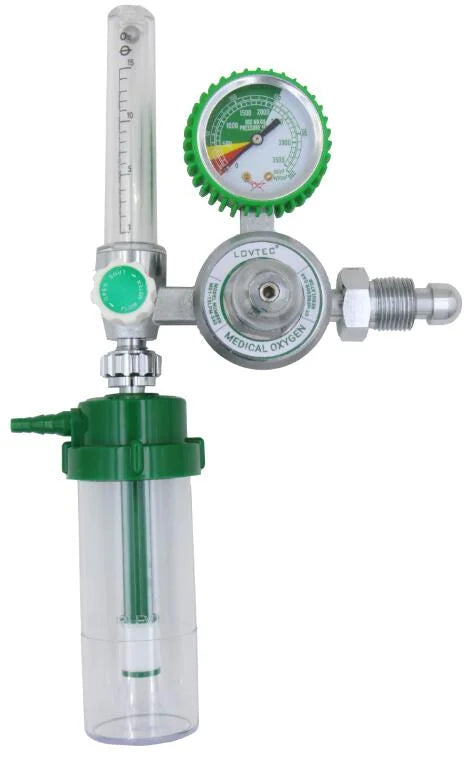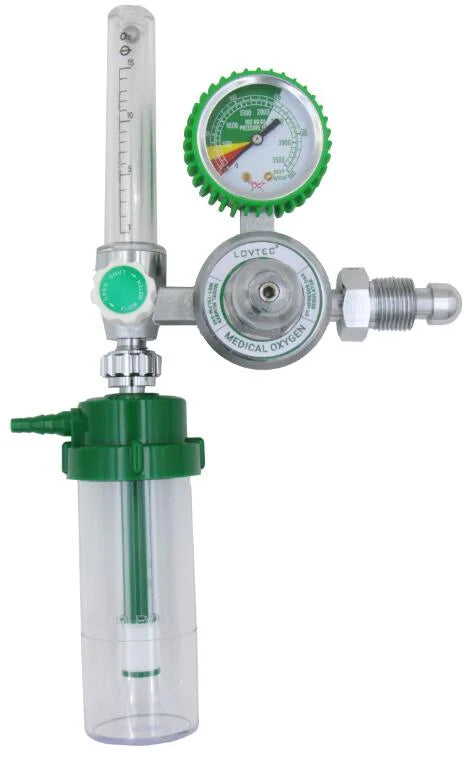1
/
of
1
Medworld Trade
Bull Nose Regulator
Bull Nose Regulator
Regular price
Dhs. 499.00 AED
Regular price
Sale price
Dhs. 499.00 AED
Unit price
/
per
Couldn't load pickup availability
Bull Nose Regulator Reliable oxygen cylinder regulator for safe and accurate oxygen delivery.
- Oxygen therapy requires safe and controlled oxygen delivery to the patient. It is where the Bull Nose Regulator or oxygen cylinder regulator plays an important role.
- The device regulates the oxygen flow through the cylinder and enables medical staff to adjust the dosage to the patient's needs.
- Pressure regulators, also called oxygen cylinder regulators, are important elements in oxygen distribution systems.
- They connect directly to an oxygen cylinder and regulate the oxygen supply directly to the patient.
- They regulate flow by ensuring that air is delivered to the tubing. Here are the features of oxygen cylinder regulators.
Advantages of Bull Nose Regulators
Safe and controlled oxygen delivery
- The Bull Nose Regulator ensures controlled oxygen delivery to patients by allowing healthcare professionals to control flow and pressure and ensure precise delivery without the risk of under or over-oxygenation.
Tailored oxygen therapy
- Healthcare professionals can use the regulator's variable flow rate to tailor oxygen therapy to each patient's needs, providing the optimal amount of oxygen to treat the condition effectively.
Real-time monitoring
- The Bull Nose regulator's meters provide real-time monitoring of the oxygen flow rate, allowing healthcare professionals to closely monitor therapy sessions and adjust as needed to achieve the desired amount of oxygen.
Reliable and Durable
- Bull Nose regulators are made of rugged materials to ensure their reliability in the medical field and to provide continuous oxygen delivery over time.
Features of Bull Nose Regulator
Pressure regulation
- With the flexible pressure regulator, healthcare professionals can quickly and precisely regulate the oxygen flow and adjust it to the patient's wishes and needs.
- This feature enables the optimal use of oxygen in a group of patients.
Oxygen flow control
- With the help of a regulator, healthcare professionals can regulate the flow of oxygen precisely according to patients' needs and prescriptions, providing them with vital oxygen.
Easy-to-read gages
- The Oxygen Cylinder Regulator features easy-to-read gages that indicate the pressure in the cylinder and the oxygen flow rate, allowing healthcare professionals to monitor oxygen levels during treatment and make adjustments as needed.
Durable construction
- Oxygen Cylinder Regulator are made of durable materials such as aluminum or brass to ensure optimal performance in medical environments and frequent use.
Oxygen Cylinder Regulator
SPECIFICATIONS
| Packaging Type | Box |
| Working Pressure | 50-60 Bar |
| Brand | Al-Can Exports |
| Outlet pressure | 0-100 PSI |
| Operating Temperature | -40 to 71 Deg C |
FAQs
How do I connect my Oxygen Cylinder Regulator to an oxygen cylinder?
- Connecting the Oxygen Cylinder Regulator is a straightforward process.
- Close the oxygen cylinder valve, align the regulator outlet with the cylinder valve outlet, close the valve clockwise, open it slowly to start the oxygen flow, and relax!
Can the Oxygen Cylinder Regulator be used for both adults and children?
- Yes, it can. The Bull Nose regulator offers the possibility to adjust the flow rate to each patient's individual needs, regardless of their age.
Are Oxygen Cylinder Regulator compatible with different oxygen cylinders?
- Bullnose regulators are compatible with most standard oxygen cylinders.
- However, a secure and tight fit must be perfectly matched to the type of cylinder used.
How often should Bullnose regulators be tested to ensure their accuracy?
- It is recommended that healthcare professionals regularly check the accuracy of Oxygen Cylinder Regulator according to the manufacturer's recommendations to ensure optimal flow rates and pressures.
- Regular calibration and maintenance checks should be performed frequently to ensure accurate flow rate and pressure measurements.
Share


